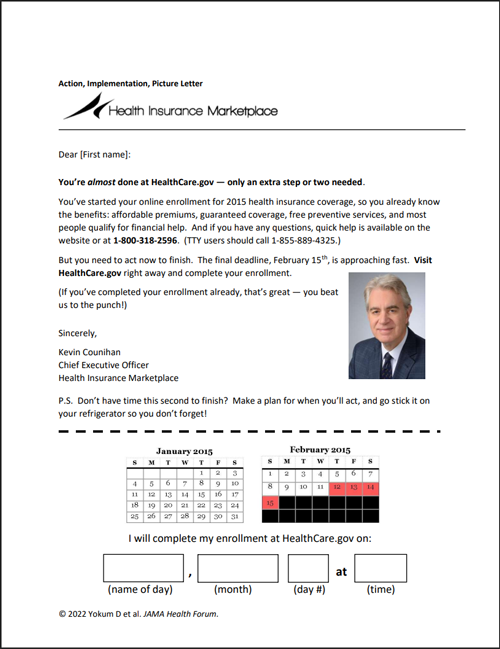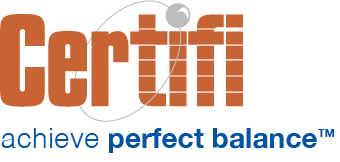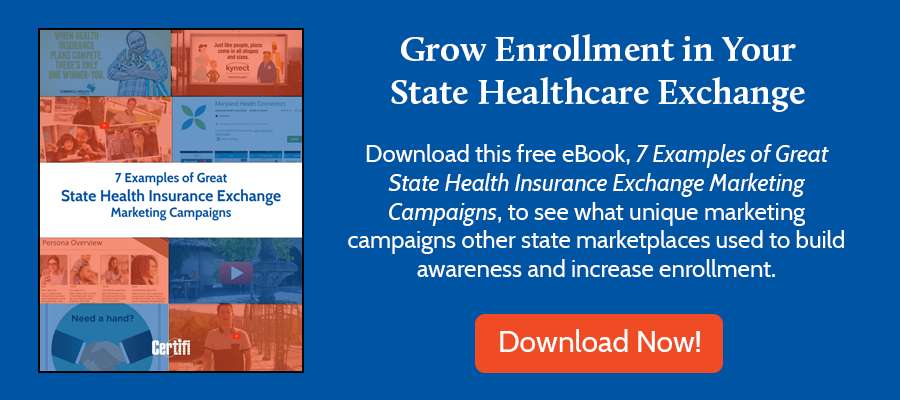We’ve previously reviewed state health insurance exchange marketing campaigns as well as state exchange open enrollment marketing plans. Today, we’re going to take a look at how to improve state health insurance exchange direct mail marketing by reviewing a recent randomized clinical trial report, Effectiveness of Behaviorally Informed Letters on Health Insurance Marketplace Enrollment.
About the Study
This study is relatively dated — it occurred in 2015. But it offers good insight into how to conduct direct mail marketing outreach to individuals who have started an open enrollment application, but haven’t completed enrollment. In the trial, 744,510 individuals who started the enrollment process but didn’t complete it, were targeted with letters urging them to enroll. The letters were sent during the last two weeks of the 2015 enrollment period to individuals in 37 states that used the healthcare.gov federal ACA exchange platform.
The individuals were randomized into 9 different groups. 1 control group to whom no letter was sent, and then 8 other groups that were sent different variants. The variants all included the same core message. That included the benefits of enrolling, the sign-up deadline, the website, and the call center phone number. The difference among the letters included that each leveraged different messages based on behavioral research. For example, some messages used action language. They indicated that the individual had nearly completed enrollment. Others included the same language with an image or a stub reminder. Some used social norm language — others have enrolled, but you haven’t. Others incorporated loss aversion language — if you don’t get health coverage, you could pay a fee.
 Study Results
Study Results
Of the 8 letters, two did not increase enrollment. The social norm letter that included a pledge to enroll and the so-called kitchen sink letter that used a combination of all 8 letters performed the worst. The three action language letters performed the best. A letter containing an implementation prompt and a picture performed best. The study’s authors found that sending the highest performing letter would have translated to 3228 marginal enrollees at a cost of $104 per new enrollee.
The authors also examined the letters’ impact on different populations. They found statistically significant differences for most populations, with the largest enrollment increase among Hispanic adults. However, individuals younger than 30 didn’t see a statistically significant enrollment increase.
State Health Insurance Exchange Direct Mail Marketing Tips
With those results in mind, here are five state health insurance exchange direct mail marketing tips:
Send Letters to Those That Began Enrolling, But Didn’t Finish
Send direct mail to those who began the enrollment process, but didn’t finish. As these results show, doing so will likely increase enrollment and the cost is negligible. In this instance, it cost an average of $191 per new enrollee. The best performing letter would have a cost nearly half that – $104 per new enrollee.
A/B Test Your Letters
Always be testing. These letters tested messaging. But they also tested the use of images and tools that helped individuals remember to enroll. Do the same with every message you send. As these letters found, action letters with an image and implementation prompt performed best among this population. So the next open enrollment period would be a good time to fine-tune certain elements of the letter. You could use different images, different implementation prompts, or even different action language. By constantly testing different letters, you’ll be able to fine-tune your message and letter over time. This consistent testing will likely lead to incremental enrollment gains.
Use Action Language
In this example, the action language focused on how the individual was almost done enrolling and that just a few more steps were all that were needed to complete enrollment. That language outperformed social norm language — others are doing it, but you haven’t — as well as loss aversion letters which focus on the negative consequences of failing to enroll.
Accentuate low-cost options to certain populations
As the study pointed out, a large percentage of the population is still unaware that subsidies exist to reduce the cost of health insurance. As a result, accentuating low-cost options may make a significant impact. The study also found that ethnic minorities in Medicaid expansion states were more likely to enroll as a result of the action letters. Their hypothesis as to why: Low-income individuals in non-expansion states tend to have higher premiums and don’t have access to subsidies, so cost is a bigger barrier than it is in expansion states.
Send Letters Early
Though there are no data from this study that compares sending letters early vs. late in the open enrollment period, it’s likely that sending early — and even sending multiple letters — may positively impact enrollment. This study sent letters near the end of the enrollment period. They heard that some letters may have arrived after open enrollment closed. So sending letters earlier or sending a series of letters may impact the enrollment the most.
Be Specific
Finally, most marketers know that personalization can be the key to success. In the case of letters, once you’ve done some A/B testing on large populations, start personalizing and testing letters to smaller populations. For example, this study found letters didn’t impact the under 30 population. Try messaging or formats specific to that population to see if anything results in statistically significant enrollment increases. Tailoring messages to specific populations may help improve overall enrollment results.
Certifi helps state health insurance exchanges improve enrollment and build a better member experience with state insurance exchange premium billing and payment solutions.



